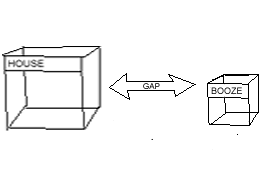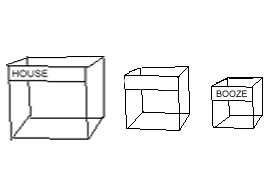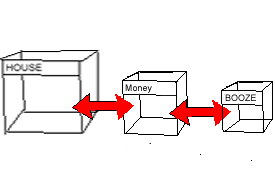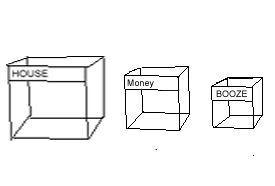The Friendly Fire Room Presents
Listen And See
Thank you Wanda Barlow for this great idea!
Pronouns Metaphors Errors Part 15
Pronouns Metaphors Errors Part 15
Pronouns, Metaphors, and Errors
Message
February 1, 2015
Part 15
Last week we dropped the burdensome term “metalepsis” and replaced it with its English equivalent, “double-metonymy”.This week we will drop the term “metonymy” and replace it with its English equivalent, “name-change”. Now, for metonymy and metalepsis we simply have... “name-change” and “double-name-change”!
The blood{ x ( y )} of Christ
Last week I gave you the result of the evaluation required to identify the words x and y, the process involved in deciphering our double-metonymy, “the blood of Christ”. The result turned out to be”: “the blood{ death( atonement)} of Christ”. Please, somebody ask me, “Why have you waited so long to drop the Greek terms for these figures of speech?”
Because...
1. If we hadn’t gone over the original Greek meanings of them, the foundation for your understanding these terms would be weak and lack real substance.
This week you will need to learn the mental process involved in arriving at a valid answer for yourself, then learn how to apply your knowledge at a practical level and become proficient at the task of deciphering metonymies and double-metonymies yourself.
2. So that you might get a first-hand understanding how it came to be that one of the reasons figures of speech in the Scriptures are for the most part either ignored or misunderstood is due to the difficulty dealing with the Greek and Latin nomenclature tending to deter disciples of Christ from studying the subject of Figures.
3. Until the last century, there hasn’t existed a comprehensive classification of the more than 200 figures. If the Greeks did this work, no record of it seems to have come down to us.
Figures are used extensively in the Hebrew and Greek texts. The ancient Greeks simply were expertise in defining and describing their use.
Examples:
“The ground is thirsty” is used for “the ground needs rain”.
“The crops suffer.”
“God hardened his heart.”
“God turns the heart of man.”
Let’s say that we want to make a brief but comprehensive statement package in the form of a figure of speech. Our goal is to produce a figure that is capable of telling a particular story using the least number of words as possible, and yet elicit the same kind of response of feelings as would a wordy, fully-detailed account of the same devastating story.
The rule of thumb:
Whenever and wherever it is possible, the words of Scripture are to be understood literally, but when a statement appears to be contrary to our experience, or to known fact, or revealed truth; or seems to be at variance with the general teaching of the Scriptures, then we may reasonably expect that some Figure is being used, to call our attention and prompt us to discover the truth that is emphasized.
The story: It is a tragedy which occurred over an extended period of time in the life of a certain man who, having an uncontrollable drinking problem, spent all his money to buy booze, then resorted to selling his house to buy more booze, until finally all that money was gone as well.
After last week and today I hope you will have learned what exactly it means “to leave out a necessary portion of something having an affinity relationship with” another thing in the double- name-change figure of speech.
Today, I trust that this will all become perfectly clear to you as we pretend to be a writer of Scripture, and walk through the steps required to actually create a double-name-change figure of speech.
Our intent is to make our statement as powerfully clear and brief (succinct) as possible; so, we will use a double-name-change double-metonymy), which will allow us to omit much detail necessary to the story, while at the same time providing enough information for the thinking reader to work with in order to discover the obvious relationships of affinity that exist between the nouns in our story.
Then the reader can use his own thinking process to fill in the gaps of necessary information and complete the story for himself.
Let’s begin by identifying the subject of our story simply as: “The man”.
Let’s identify the key verb that conveys the highest level abstraction of the man’s actions; namely, “he drank.”

(Q) Why rename “booze” with “all his money”? What possible affinity relationship is there between “all his money” and “booze”?
Think about it...
(A) Because the man transferred or changed“ all his money” into “booze” himself,in order to buy the booze.
Now, we need a predicate to make a complete sentence. The most obvious predicate would be “booze”, but saying “The man drank booze” fails to fully communicate the tragedy of our story.
What if, instead of using the word name “booze” we rename it “all his money”; that is, we create a name-change (a metonymy)?
OK, let’s add the fact that he sold his house to get the money in the first place. (He liquidated it.) We will then present this information as one sentence consisting of a two-stage statement.
“The man sold his house for money, then drank all his money.”
This compound sentence is indeed powerful, but we can make it more powerful.
So, here’s one of our name-changes:“ The man drank all his money.”
Wow!
Think about it.
This sentence makes a powerful statement. Look at it again- Notice that there are two stages in the progression of “The man sold his house for money, then drank all his money” this story; both involving the word “money”.
Can you see the potential value for creating a powerful double-name-change based upon the obvious relationship of affinity provided by the word which is common to both “house” and “booze”; namely, the word “money”?
What if we use a double-name-change and put the word “house” for both the “money acquired by the sale of his house” and the “money which he used to purchase the booze”, then pack it all together into a single box named “house”?
Syntax: house{ x ( y )} house{ money( booze)}
Good idea?

So, from the view of our reader looking at our double- name-change the first time, he will notice that the word “house” is a figure of speech, because, from experience he knows that the man could not have actually drunk the blocks, mortar, and stucco.
What do we get?
“The man drank his house.”
(Q) Will that work?
(A) I think so.
Side-note:
Does this expression kind of remind you of the words Jesus spoke to certain Pharisees and scribes?
Matthew 23:24
“Blind guides, who strain out a gnat (mosquito) and swallow a camel!”

The “booze” is what the man actually drank.
Note: The reader would actually come to the idea that booze was what he drank based on the context.The presupposition is that in our text, we had been talking about the potential dangers of alcohol, etc.
Let’s test it. “The man drank his house.”
(Q) What does the decoding process look like from the reader’s point of view?
(A) Take a look...
Now, the gap between these two nouns is too wide for a direct affinity relationship to exist between them.

Now, the gap between these two nouns is too wide for a direct affinity relationship to exist between them. So the reader will consider what necessary portion of information was left out, and provide for himself an intermediate noun to provide the relationships necessary and to establish a sensible link of affinity between the nouns, “house” and “booze”.

The deficient element consists of a middle noun which has to be supplied by the reader’s mental processes. That is why a correct translation of our figure of speech requires a “thinking reader”. If the reader is not “thinking clearly” and forces the word “house” into a literal meaning, much error will be introduced, and the true meaning of our expression will become twisted and highly distorted.

What would your response be to someone, who after reading your statement, insisted to everyone who would listen, that...“The man actually drank his house”... because these are the exact words you had written?
“The man drank his house.”
Note: Because something more is deficient in the double-name-change than in a single-name-change, the necessary parts which are omitted have to be supplied entirely by a more complex thought process, than is required by simply looking for a direct relationship of affinity between just two words as in a single-name-change.
With our example, the consequence of mistranslation is not serious; but when this type of translation error occurs with the Word of God, then the distortion could, and does raise serious consequences!

So, the reader gets it; that we put the word “house” for the word “money”, to create one name-change.


When he reads the word “house”, in order for the double-name-change to convey our intended meaning, he will need to think the words “house” and “money” inclusively because of the relationships of affinity between these two nouns.

So, the reader gets this too; the writer put the word “money” for the word “booze”, thus creating a second name-change.

The noun “money” is the intermediate term which stands in direct relationship with both “house” and “booze”.


These are the three boxes the reader must deal with inclusively in his mind, in order to receive the correct meaning of this double-name-change.
(Q) Can we expect a reader to be capable of deciphering our double-name-change (i.e The man drank his house.), and capable of discovering the proper relationships of affinity between the house, the money, and the booze, and capable of reconstructing the whole story in his head, almost instantaneously?
(A) Yes! only if he properly identifies our statement as a figure of speech. While he will be surprised at first by the unexpectedness of our expression; in the end, he will be pleased to have figured it all out, and most likely, he will remember the joy of his discovery and the sadness of the impact of this tragic story on him, for a long time!
Both, the name-change and the double-name- change, describe relationships of affinity, so all their parts are to be interpreted inclusively.
The idea of conceptually portraying the double-name- change as one encapsulated object, inclusive of two relationships of affinity, plays

a critical part in the process of properly interpreting (decoding) this kind of figure of speech.
Here it is!

Many will be surprised on the Day of Judgment
when they discover
that it was just as the Word of God says;
only the righteousness of Christ is able to save you.All men are sinners and no one can save himself.
God is just, so He must punish sin;
but He is also merciful, moreover gracious,
and offers His Son as the perfect sacrifice
in order to purchase a place for you in heaven,
which He offers to you as the free gift of eternal life.Jesus is the Christ, the Messiah,
the Anointed One, He is God Incarnate.
In order to pay the debt of our sins,
He came from Heaven, having been sent by the Father,
where He lived a life of perfect obedience to the Father
even unto the shameful death upon the cross
in order to pay the debt of your sins.This gift must be received by faith,
believing that Jesus’ perfect life and Cross Work
was His complete and necessary Atonement
for your sins, in your behalf.
Faith is a gift that comes by the Power of God the Holy Spirit working in a person’s innermost being.
Only the power of God can open your heart to the willingness to have the void within it filled
with the presence of Christ by His Spirit.The Holy Spirit has the authority and power to quicken your dead spirit, to make it come to life.
Only the life of His Spirit’s quickening of your heart will allow the Gospel message of salvation to even make sense to you, to truly “hear” the message and give you the ability,
as the Holy Spirit bears witness to Jesus,
to recognize your need for forgiveness and restoration, and gain the desire of your heart to be favorably inclined to want to receive Christ as your personal Lord and Savior.If you have not done so before this moment,
ask Jesus to forgive you your sins,
tell Him you’ve stop trying to be your own savior,
and ask Him to come into your life right now,
and to give you eternal life. Then, in faith believing,
thank Him for the gift that He is giving you,
the one He paid for in full in your place,
in Jesus’ name,
AMEN
Copyright February, 2015
Rev. Jim Craig
All Rights Reserved
Bibliography
Agnes, Michael and Charlton Laird (eds.). Webster’s New World Dictionary and Thesaurus. New York, NY: Macmillan, 1996.
Aland, Kurt, Matthew Black, Carlo M. Martini, Bruce M. Metzger, and Allen Wikgren (eds.). The Greek New Testament, 4th rev. ed. Germany: Biblica-Druck, 1994.
Benner, Jeff A. The Ancient Hebrew Lexicon of the Bible. College Station, Texas: Virtualbookworm.com Publishing Inc., 2005
Bullinger, E. W. Figures of Speech Used in the Bible; Explained an Illustrated. Grand Rapids, Michigan: Baker Book House, 2007.
Chapman, Benjamin. Greek New Testament Insert. Grand Rapids, Michigan: Baker Book House, 1977.
Dana, H. E., and Julius R. Mantey. A Manual of the New Testament. Canada: The Macmillan Company, 1957.
Louw, Johannes P. and Eugene A. Nida. Greek-English Lexicon of the New Testament Based on Semantic Domains. New York, NY: United Bible Societies, 1989.
The ESV Study Bible. Wheaton, Illinois: Crossway, 2011.
Metzger, Bruce M. Lexical Aids for Students of New Testament Greek. Princeton, New Jersey, 1977.
Wikipedia contributors. "Xenophon." Wikipedia, The Free Encyclopedia. Wikipedia, The Free Encyclopedia, 15 Aug. 2014. Web. 19 Aug. 2014.
Wuest, Kenneth S. The New Testament; An Expanded Translation. Grand Rapids, Michigan, 1992.
Wuest, Kenneth S. (Revised, Donald L. Wise). The Practical Use of the Greek New Testament, rev. ed. Chicago, Il: Moody Press, 1982.
Walsh, J. Martyn and Anna Kathleen Walsh. Plain English Handbook: A Complete Guide to Good English, 7th rev. ed. Cincinnati, Ohio: McCormick-Mathers PublishingCompany,1977.